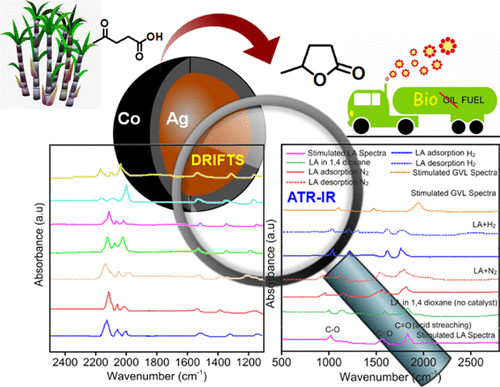当前位置:
X-MOL 学术
›
ACS Sustain. Chem. Eng.
›
论文详情
Our official English website, www.x-mol.net, welcomes your
feedback! (Note: you will need to create a separate account there.)
Looking into More Eyes Combining In Situ Spectroscopy in Catalytic Biofuel Upgradation with Composition-Graded Ag–Co Core–Shell Nanoalloys
ACS Sustainable Chemistry & Engineering ( IF 7.1 ) Pub Date : 2021-03-04 , DOI: 10.1021/acssuschemeng.0c08670 Paramita Koley 1, 2 , Subhash Chandra Shit 1, 3 , Ylias M. Sabri 2 , Bolla Srinivasa Rao 1 , Lingaiah Nakka 1 , James Tardio 2 , John Mondal 1, 3
ACS Sustainable Chemistry & Engineering ( IF 7.1 ) Pub Date : 2021-03-04 , DOI: 10.1021/acssuschemeng.0c08670 Paramita Koley 1, 2 , Subhash Chandra Shit 1, 3 , Ylias M. Sabri 2 , Bolla Srinivasa Rao 1 , Lingaiah Nakka 1 , James Tardio 2 , John Mondal 1, 3
Affiliation

|
γ-Valerolactone (GVL), which can be generated from levulinic acid (LA), has attained a humongous amount of interest due to its implantation in various fields, which includes fuels and fuel additives. Herein, for the first time, we have sequentially synthesized silver–cobalt core–shell nanoalloy-based catalysts through a simple wet impregnation method for selective conversion of LA to GVL. The highest catalytic proficiency (97.3 LA conversion with 100% GVL selectivity) had been achieved over a composition-graded optimized catalyst, named 5Ag–15Co, under comparatively moderate reaction conditions (150 °C, 1 MPa H2 pressure). The catalyst structure–activity relationship has been established through an extensive range of in situ spectroscopic characterizations, which included in situ X-ray photoelectron spectroscopy (XPS), in situ CO-diffuse reflectance infrared Fourier transform (DRIFT) spectroscopy, and in situ attenuated total reflection-inferred (ATR-IR) spectroscopy. The extraordinary catalytic activity could be attributed to the modulation of electronic properties, which is mainly due to the synergistic interaction in the core–shell alloy system, as confirmed from in situ XPS studies. The presence of the highest amount of metallic cobalt in the 5Ag–15Co catalyst, which was evidenced by both in situ XPS and in situ CO-DRIFT, could assist the hydrogenation step in hydrodeoxygenation of LA to GVL. This finding also was emphasized by H2 chemisorption analysis, which revealed the presence of the highest active metal surface area in the 5Ag–15Co catalyst. In situ ATR-IR has elucidated that moderate interaction, which was generated between the catalyst and LA, has enhanced the rate of reaction. This finding also has been emphasized by the results obtained from NH3-TPD analysis, which revealed that the presence of high surface density of Lewis/weak acidic sites facilitated the hydrogenation step in the hydrodeoxygenation (HDO) reaction. The detailed kinetic analysis revealed that the 5Ag–15Co catalyst had the lowest activation energy (41.34 kJ) among its counterparts, which accelerated the reaction rate.
中文翻译:

结合成分分级的Ag-Co核-壳纳米合金,探索更多结合现场原位光谱技术进行催化生物燃料升级的研究
可以从乙酰丙酸(LA)生成的γ-戊内酯(GVL),由于其在包括燃料和燃料添加剂在内的各个领域中的广泛应用而引起了人们的极大兴趣。在这里,我们首次通过简单的湿法浸渍法,顺序合成了银-钴核-壳纳米合金基催化剂,以选择性地将LA转化为GVL。在相对适中的反应条件(150°C,1 MPa H 2压力)下,采用成分分级的优化催化剂5Ag-15Co可获得最高的催化效率(97.3 LA转化,GVL选择性为100%)。催化剂的结构活性关系已经通过广泛的原位光谱表征建立,其中包括原位X射线光电子能谱(XPS),原位CO扩散反射红外傅里叶变换(DRIFT)光谱和原位衰减全反射推断(ATR-IR)光谱。出色的催化活性可以归因于电子性能的调节,这主要归因于原位XPS研究证实的核-壳合金体系中的协同相互作用。原位XPS和原位CO-DRIFT都证明5Ag-15Co催化剂中金属钴含量最高,这可以协助LA加氢脱氧为GVL的加氢步骤。H 2也强调了这一发现。化学吸附分析表明,在5Ag-15Co催化剂中存在最高的活性金属表面积。原位ATR-1R已经阐明了催化剂和LA之间产生的适度相互作用提高了反应速率。从NH 3 -TPD分析获得的结果也强调了这一发现,该结果表明,路易斯/弱酸性位点的高表面密度的存在促进了加氢脱氧(HDO)反应中的氢化步骤。详细的动力学分析表明,5Ag-15Co催化剂的活化能最低(41.34 kJ),这加快了反应速度。
更新日期:2021-03-15
中文翻译:

结合成分分级的Ag-Co核-壳纳米合金,探索更多结合现场原位光谱技术进行催化生物燃料升级的研究
可以从乙酰丙酸(LA)生成的γ-戊内酯(GVL),由于其在包括燃料和燃料添加剂在内的各个领域中的广泛应用而引起了人们的极大兴趣。在这里,我们首次通过简单的湿法浸渍法,顺序合成了银-钴核-壳纳米合金基催化剂,以选择性地将LA转化为GVL。在相对适中的反应条件(150°C,1 MPa H 2压力)下,采用成分分级的优化催化剂5Ag-15Co可获得最高的催化效率(97.3 LA转化,GVL选择性为100%)。催化剂的结构活性关系已经通过广泛的原位光谱表征建立,其中包括原位X射线光电子能谱(XPS),原位CO扩散反射红外傅里叶变换(DRIFT)光谱和原位衰减全反射推断(ATR-IR)光谱。出色的催化活性可以归因于电子性能的调节,这主要归因于原位XPS研究证实的核-壳合金体系中的协同相互作用。原位XPS和原位CO-DRIFT都证明5Ag-15Co催化剂中金属钴含量最高,这可以协助LA加氢脱氧为GVL的加氢步骤。H 2也强调了这一发现。化学吸附分析表明,在5Ag-15Co催化剂中存在最高的活性金属表面积。原位ATR-1R已经阐明了催化剂和LA之间产生的适度相互作用提高了反应速率。从NH 3 -TPD分析获得的结果也强调了这一发现,该结果表明,路易斯/弱酸性位点的高表面密度的存在促进了加氢脱氧(HDO)反应中的氢化步骤。详细的动力学分析表明,5Ag-15Co催化剂的活化能最低(41.34 kJ),这加快了反应速度。











































 京公网安备 11010802027423号
京公网安备 11010802027423号